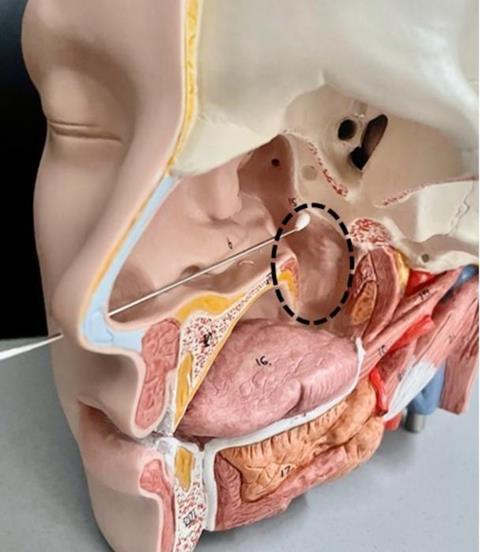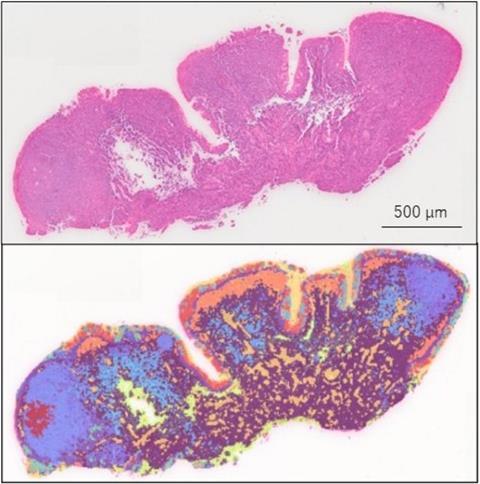Researchers in Japan have made a groundbreaking discovery in the fight against long COVID.
A team of researchers led by Researcher Kensuke Nishi from the Oral Medicine Research Center, Fukuoka Dental College, Japan, and Dr. Akira Watanabe from CyberomiX Inc., Japan, has identified the epipharynx, a part of the pharynx, as a key site for chronic inflammation driven by residual SARS-CoV-2 RNA.

Using a next-generation molecular mapping technology called Visium HD spatial transcriptomics, the team provided the world’s first high-resolution spatial gene expression analysis of the epipharynx in patients with long COVID. The findings of the study were published in Volume 15 of Scientific Reports on March 12, 2025.
Primary target
The epipharynx is lined with ciliated epithelium. It serves as a primary target for most upper respiratory tract infections, and its significance became particularly evident during the COVID-19 pandemic. While inflammation of the epipharynx has been associated with long COVID symptoms, the underlying mechanisms have remained unexplained until now.
READ MORE: Study finds persistent infection could explain long COVID in some people
READ MORE: Viral persistence and serotonin reduction can cause long COVID symptoms
According to the study, the viral RNA from SARS-CoV-2 can persist in the epipharynx for more than six months post-infection, and here they activate local immune signals in specialized cells like B cells, plasmacytoid dendritic cells, and ciliated epithelial cells. This signaling potentially contributes to the chronic symptoms experienced by patients with long COVID, which include fatigue, persistent cough, dizziness, and cognitive issues continuing for months after the acute phase of infection.
“Our study is the first in the world to apply Visium HD spatial transcriptomics to map the epipharynx of patients with long COVID. Using this advanced technique, we found that the residual viral RNA isn’t merely leftover debris; instead, it actively triggers immune responses and inflammation. The epipharynx is one of the most important sites for SARS-CoV-2 infection, yet its anatomical location makes it difficult to observe without endoscopic evaluation. We hope that this region will gain more clinical and research attention as a potential target in understanding and treating long COVID,” says Dr. Nishi.
Epipharyngeal abrasive therapy
To address the issue, the team explored epipharyngeal abrasive therapy (EAT) as a treatment. EAT is a treatment for chronic epipharyngitis that has been practiced in Japanese otolaryngology since the 1960s, involving the swabbing of the epipharynx with a 1% zinc chloride solution. After three months of weekly EAT treatment, the patients showed a remarkable improvement in symptoms.

On a closer analysis, the researchers observed a significant reduction in the viral RNA and a suppression of inflammatory responses marked by a decrease in expression of signaling molecules like pro-inflammatory cytokines and antibody-related genes.
The spatial gene analysis post-treatment revealed that EAT promotes the removal of damaged ciliated epithelium. Additionally, it also downregulates the overactive immune pathways, underscoring its promising role in immune modulation and tissue repair.
Hidden reservoir
“Spatial transcriptomic analysis has enabled a deeper understanding of the biology of long COVID from a completely different perspective than conventional approaches, including the potential application of a treatment already in clinical use in Japan,” remarks Dr. Watanabe.
The spatial transcriptomic data from this study are publicly available via the EMBL’s ArrayExpress database (accession number: E-MTAB-14669), encouraging further research in this area. While the current study included only a small sample size, the authors confirm that a multi-center clinical trial for validating the efficacy of EAT across a broader population in Japan is now underway.
The study marks a significant leap in medical science, especially in light of estimates showing that 31–69% of recovered COVID-19 patients continue to suffer lingering symptoms. While most existing treatments focus on managing these symptoms, this study goes deeper, identifying the epipharynx as a hidden reservoir of viral RNA and immune disruption, thereby opening new avenues for more targeted therapies.







No comments yet